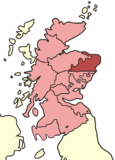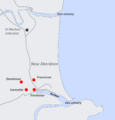Diocese of Aberdeen facts for kids
 |
|
| Head | Bishop of Aberdeen |
|---|---|
| Archdeacon(s) | Archdeacon of Aberdeen |
| Known rural deans | Aberdeen, Boyne, Buchan, Garioch, Mar |
| First attestation | 1131 x 1132 |
| Metropolitan before 1472 | None |
| Metropolitan after 1492 | Archbishop of St Andrews |
| Cathedral | St Machar's Cathedral |
| Dedication | St Machar |
| Native dedication | Saint Machar |
| Canons | Secular |
| Catholic successor | Resurrected 4 March 1878 (see Roman Catholic Diocese of Aberdeen) |
| Episcopal successor | Diocese of Aberdeen and Orkney |
The Diocese of Aberdeen was an important church area in Scotland during the Middle Ages. For a long time, people thought it started from an older church area in a place called Mortlach. But later, it was found that the old records about this were not true.
The first real bishop of Aberdeen we know about was Nectan, mentioned around 1132. The first clear written proof of a bishop in Aberdeen came in 1157. This was a special letter from the Pope, called a Papal Bull, to Bishop Edward. It talked about his main church, called a cathedral, and how the church structure was growing.
Contents
The Diocese of Aberdeen: A Look Back
The Diocese of Aberdeen was a big church area in Scotland. It was led by a bishop and had many churches and priests.
Early Days and Myths
Some old stories say the diocese started in Mortlach, a town in Moray. These stories mention early bishops like Bean and Nectan. However, these tales came from old documents that are now known to be fake. The only real mention of Nectan as Bishop of Aberdeen is a small note from around 1132 in a book called the Book of Deer.
Even so, Mortlach was an important church place early on. In 1157, Pope Adrian IV sent a special letter confirming that Mortlach had a main church and five smaller churches that belonged to the Diocese of Aberdeen. At that time, these churches were often run by groups of priests called Culdees (Céli Dé). They lived in communities and served the local people.
How Churches Grew Stronger
In 1157, Pope Adrian IV also confirmed that Bishop Edward had churches in Aberdeen, including St Machar and St Nicholas. He also had control over the town of Old Aberdeen and other lands. The Pope allowed Bishop Edward to create a "chapter" for his cathedral. This was a group of important priests who would help him run the diocese.
King David I helped make big changes to how churches worked in Scotland. He made rules that protected the rights of local churches and their priests. These rules made sure that people gave a part of their crops or income, called tiends, to support their priests. This helped local churches become stronger and more organized.
Local lords often built churches. Over time, many of these lords gave their rights to support these churches to the cathedral or to monasteries. This made the cathedral and monasteries very rich. The cathedral used this money to pay its many priests, called canons. These canons were supposed to make sure the local parish priests, called vicars, had enough money. But often, the vicars were paid very little.
Building the Cathedral
The main church of the diocese, St Machar's Cathedral, was rebuilt over many years. Work started in the late 1300s and continued into the 1500s.
- Bishop Alexander Kininmund (1355–80) started by making the walls of the west towers and the main hall taller.
- Bishop Henry Lichton (1422–40) finished what Kininmund started and built the north part of the church.
- Ingram Lindsay (1441–58) added the roof and floor to the main hall.
- Thomas Spens (1457–80) made the inside of the church beautiful.
- Bishop William Elphinstone (1483–1514) finished the central tower. He also started rebuilding a larger choir area.
- Gavin Dunbar (1518–32) completed the south part of the church and added spires to the west towers. He also created the famous ceiling in the main hall, which shows the coats of arms of important leaders.
Church Organization
The bishop was in charge of the cathedral, local churches, and hospitals. Monasteries were mostly independent, but they still needed the bishop for some things, like ordaining monks to become priests.
The Cathedral and its Leaders
The main church of the diocese was St Machar's Cathedral. It was run by the bishop and a group of important priests called the cathedral chapter.
Bishops of Aberdeen
- Nectan, fl. 1131/2
- Edward, fl 1147/51-1171
- Matthew, 1172–1199
- John, 1199–1207
- Adam de Kalder, 1207–1228
- Matthew Scot, postulated 1228
- Gilbert de Stirling, 1228–39
- Radulf de Lambley, 1239–47
- Peter de Ramsey, 1247–56
- Richard de Potton, 1256–70 or 1272
- Hugh de Benin, 1272–82
- Henry le Chen, 1282–1328
- Walter Herok, elect and provided but not consecrated, 1329
- Alexander de Kyninmund (I), 1329–1344
- William de Deyn, 1344–1350
- John Rait, 1350-1354/5
- Alexander de Kyninmund (II), 1355–80
- Simon de Ketenis, elected 1380 but not provided
- Adam de Tynyngham, 1380-9
- Gilbert de Greenlaw, 1390–1421
- Henry de Lychton, 1422–1440 translated from Moray
- Ingram Lindsay, 1441–58
- Thomas Spens, 1457–80 translated from Galloway
- Robert Blackadder, 1480–83
- William Elphinstone, 1483–1514 translated from Ross
- Alexander Gordon, 1514/15-18
- Robert Forman, before 1515–16
- Gavin Dunbar, 1518–32
- George Learmond, 1529–31
- William Stewart, 1532–45
- William Gordon, 1545–77
The Cathedral Chapter
The cathedral chapter was a group of important priests who helped the bishop. The Pope allowed Bishop Edward to start this group in 1157. Over time, more priests joined, and they took on different roles.
By 1243, the dean became the main leader of the chapter. Other important roles included:
- The precentor (also called the chanter) was in charge of all the music for church services. They also chose and taught the choirboys.
- The chancellor handled all the chapter's letters and documents. They also looked after the chapter's library and oversaw the town's grammar school.
- The treasurer managed the church's money and valuable items, like gold cups. They also made sure the church had everything it needed for services, like candles, bread, and wine.
By 1445, the chapter had 29 canons (priests). The dean, precentor, chancellor, and treasurer were the main leaders. The archdeacon and 24 other canons made up the rest of the group.
Deaneries: Local Church Areas
A Deanery was a smaller church area within the diocese. It included several local churches. The Archdeacon was responsible for these areas. He was helped by a "rural dean," who was a local priest. The rural dean visited each church every year to check the building and the priest.
The Diocese of Aberdeen had five deaneries:
- Aberdeen
- Boyne
- Buchan
- Garioch
- Mar
Parish Churches: Local Worship Places
Local churches, called parish churches, were very important. By the 1200s, a "parish" meant a specific area served by a local church. King David I helped make these local church areas strong and lasting.
Rules said that new churches had to be made of stone and have glass windows. The local people paid for the church building, while the main priest (rector) paid for the chancel (the area around the altar). Rectors also had to make sure the church had all the necessary items, like a silver cup for communion and books.
Over time, many parish churches had their income taken by larger church groups, like monasteries or cathedrals. This meant the local priests, called vicars, often had very little money. They were usually poorly paid and sometimes not well educated.
Hospitals: Care for the Needy
The Diocese of Aberdeen also had hospitals. These were not like modern hospitals. They were more like almshouses, providing care for the poor, the sick, or the elderly. People who received care were expected to pray for the souls of those who founded the hospitals.
These hospitals followed strict rules, similar to those in monasteries. Doctors rarely attended to patients. The focus was more on spiritual well-being than physical healing. Most hospitals were small, often housing fewer than 20 people.
There were eleven hospitals in the Diocese of Aberdeen. Five were in Aberdeen itself. They cared for:
- People with leprosy (a skin disease) – 3 hospitals
- Sick people (not lepers) – 1 hospital
- Sick and poor people – 1 hospital
- Elderly people – 1 hospital
- One hospital had an unknown purpose.
The last hospital built in the diocese was St Mary's almshouse, founded by Bishop Gavin Dunbar in 1532. It could house 12 old men.
Monasteries: Communities of Faith
Monasteries were communities of monks or friars. While many were independent, the bishop still had some power over them. For example, he had to ordain monks to become priests. He also had to approve when monasteries took over the income of local parish churches.
In the Diocese of Aberdeen, there were several types of monasteries:
- Carmelite Friars (White Friars) in Aberdeen.
- Dominican Friars (Black Friars) in Aberdeen.
- Franciscan Friars (Grey Friars) in Aberdeen.
- Trinitarian Friars (Red Friars) in Aberdeen.
- A Cistercian Abbey at Deer.
- A Tironensian Priory at Fyvie.
- A Preceptory (a type of monastery) for the Knights Templar and later the Knights Hospitallers at Maryculter.
- An Augustinian Priory at Monymusk.
These religious houses played a big role in the church life of the diocese.
Images for kids









